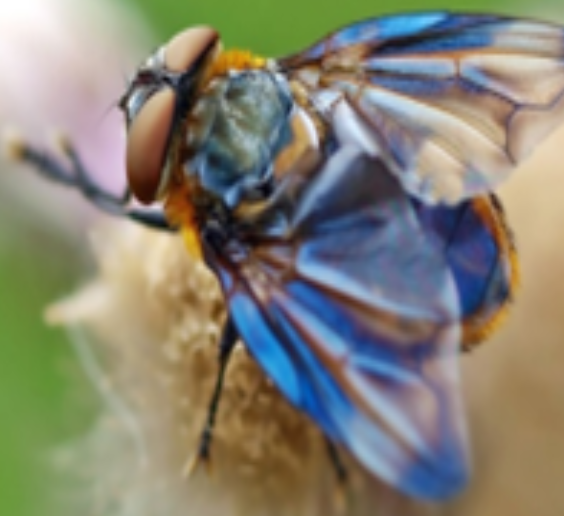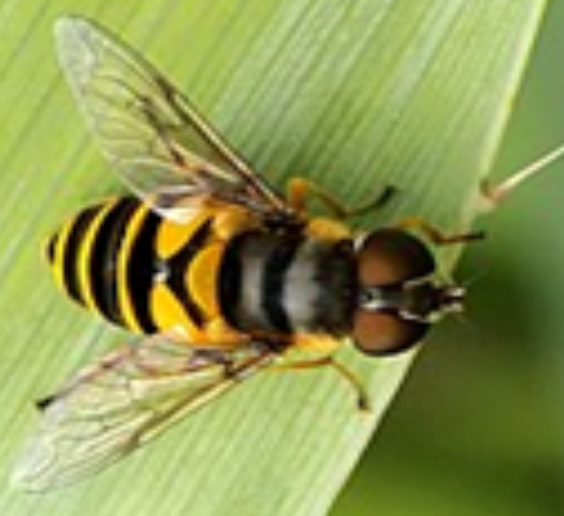Posted: June 15, 2023
Read about the relationship of flies to chocolate and other benefits of these pesky pollinators.

Image source: pixabay.com
If you wrinkle your nose at the mere suggestion of flies coming into contact with that dark chocolate truffle, and wonder why I mention the connection, you are not alone. You will be surprised at their symbiotic, beneficial relationship. By the end of this article, I hope to convince you why flies are important and deserve our respect and protection.
So, let's get started!
When asked to name insects that can pollinate plants, most people immediately think "bees". Of all the insect orders, bees are considered the most important group of pollinators worldwide. However, other insect orders are now also recognized and confirmed to contribute to plant pollination in both natural and agricultural systems. The most important of these groups is Diptera or flies. With the number of species estimated between 120,000 to 150,000, flies live nearly everywhere on Earth and are abundant in most terrestrial habitats including arctic and alpine environments. They include many familiar insects such as house flies, blow flies, mosquitoes, gnats, hover flies, black flies, midges, and fruit flies. Pollination by flies is known as myophily.
A pollinator is any animal that helps carry pollen from the male part to the female part of a flower. This movement of pollen must occur for plant fertilization to occur, in other words for seeds to be produced. Most flowering plants are pollinated by insects and other animals. To be an effective pollinator, an insect must visit flowers in such a way as to transfer pollen regularly from anthers to stigma, whether between plants, between flowers on the same plant, or within the same flower. The seeds produced as the result of pollination are the very basis of our ecosystems because plants are at the base of our food webs. These plants also stabilize our soils and help clean our air. Imagine a world without a diversity of trees, flowers, birds, and mammals. Without pollinators, our world would be a very different place.
The efficiency and effectiveness of any given pollinator is measured by the ability of that insect to move and deposit pollen between flowers. Morphological traits, such as mouth characteristics, body mass, body length, and hairiness on pollen-contacting body parts are likely to be good predictors of pollinator efficiency.
Flies are important pollinators. Flies have been estimated to contribute to pollination of at least 70% of food crops worldwide. In some environmental settings, like high altitudes and high latitudes, flies are dominate pollinators where bees are scarce or don't thrive. Their contribution is estimated to be over $300 billion worldwide. A few examples of the many fruits and vegetables that flies help pollinate include pears, apples, berries, carrots, fennel, and parsley.
Besides being important pollinators, flies play a significant role in maintaining ecological balance. Many fly species are parasitic, feeding on moth larvae (caterpillars), grasshoppers, and beetle grubs helping to keep these insect populations under control. In turn, flies contribute to the food web as they are prey for various other animals such as species of amphibians, birds, and spiders.
Another very important ecological benefit of flies is their role as decomposers. They feed on dead things: dead plant materials such as leaf litter and wood, carrion, and feces. They perform a valuable service as Earth's clean-up crew.

Let's look at the common physical characteristics of the Order Diptera. These include:
- One pair of forewings (Diptera, which is Greek for two wings)
- Hindwings reduced to club-like halteres, which are structures used for balance during flight.
- A large and moveable head
- Compound eyes that are very large
- Sucking, piercing, and sucking or sponge-like mouthparts adapted to a liquid diet.
Many organisms, Diptera included, have complex life cycles that include "an abrupt developmental change in an individual's morphology, physiology and behavior, usually associated with a change in habitat". Such an abrupt change has long been described as metamorphosis.
The life span of flies is short, usually 15-30 days. Within this period, they go through four life cycle stages: egg, larva, pupa, and adult. Female flies lay their eggs in moist and warm places, usually on decaying organic matter such as food waste, garbage, carrion, and animal feces. The eggs hatch after eight to twenty hours. Fly larvae, also called maggots, stay close to their food source. As they feed, they grow and molt three times before entering the pupa stage. The pupa stage is a period of dormancy. There is little movement and no feeding. Within a cocoon-like shell, flies develop their wings, antennae, and legs. They emerge as fully grown adults.
Most adult flies visit flowers, which provide water, nectar, and pollen. Nectar, which contains carbohydrates is used by flies to sustain flight and extend lifespan. Pollen, a source of protein and fats, supports the reproduction requirements of both sexes. Some species of adult flies also visit flowers to lay eggs.
The plants that attract flies for foraging and egg-laying are mainly in the families of Asteraceae, Rosaceae, and Apiaceae. Some flies have specialized relationships with specific flowers, while other flies are generalists, feeding from a wide variety of flowers. The flowers that are attractive to flies are typically:
- White or yellow flowers with open structures easy to access, representing a long-range visual cue during foraging.
- Pale and dull to dark brown or purple.
- Sometimes flecked with translucent patches.
- Putrid odor, like rotting meat, carrion, dung, humus, sap, and blood.
- Without nectar guides
- Are funnel-like or complex traps. Some flies have remarkably long tongues that permit them to collect nectar from correspondingly long corolla tubes.

To help protect all our pollinators, the volunteers of Penn State Extension Master Gardeners of Monroe County have created a habitat restoration demonstration garden, called Project NatureScape, that provides a welcoming habitat for bees, butterflies, moths, wasps, flies, and beetles. The garden features native plants that support various pollinators and can be incorporated into a home landscape. The mission statement of Project NatureScape is "Learning from the past, taking action in the present, and protecting the future." This garden aims to teach the public to understand the importance of providing all our pollinators a safe habitat so that they can continue to pollinate the plants that both humans and animals depend on.
To this end, Penn State Extension Master Gardeners of Monroe County have taken the following actions/steps to safeguard and increase pollinator habitats. See which ones would work in your garden spaces.
- No herbicides or insecticides are used.
- Weeds and invasive plants are pulled by hand.
- Dead plant stalks and non-flowering parts of weeds are composted by using the "chop and drop" method, leaving the chopped plant material on the ground to decompose.
- Other unwanted plant material is placed in a thick layer and between clear plastic for solarization. During hot summer months the temperature within the plastic increases to levels that kill many disease-causing organisms, weed seeds and weed seedlings.
Having a variety of flowering plants with different bloom times in the garden assures that flies will be active in the garden spring through fall. The following list includes examples of flowering plants that attract flies. The majority are native. (By definition, a native Pennsylvania plant is one that grew in Pennsylvania before the European settlers arrived, as opposed to exotic plants which came from other countries after that time period.) Those which are not native are indicated with an asterisk *. Blooming times may vary depending on your zone:
- Early spring--bloodroot* marsh marigold, dogwood, black willow trees, hellebore*, foamflower, Virginia spring beauty
- Mid-spring--common golden alexanders, blackhaw viburnum, sassafras, black cherry tree, American plum, crabapple, mayapple
- May--Queen Ann's lace*, wild dill, coralberry, yellow pimpernel, elderberry
- June-September- yarrow, whorled milkweed, Canadian honewort, rattlesnake master, smooth Sumac, lemon balm*, flowering spurge
- July--sweet bay magnolia, whorled mountain mint, brown-eyed Susan, narrowleaved, swamp or ox-eye sunflowers, white meadowsweet
- August--false chamomile, woodbine, black-eyed Susan, Canada goldenrod, stiff goldenrod, common dill*
- September--frost aster, white boneset, white zinnia*, New York aster, white wood aster

Consider a mixed planting system that creates different micro-habitats; include some areas of decaying leaves or rotting wood. Include a small pond, water feature, muddy areas, or temporary pools of water. A small tree creates its own micro-climate. And lastly, educate yourself, friends, and neighbors on the positive characteristics of pollinator flies.
But wait, what's the connection back to chocolate truffles? Chocolate comes from seeds of the cacao tree. To produce those seeds, the trees rely on the pollination services of more than a dozen species of biting flies called midges, the only known pollinator of the flower of the cocoa plant! Cocoa flowers grow directly from the tree's trunk. They cannot self-pollinate, but their structure means that only small insects can reach their pollen. There is a short window of opportunity for the flies to fulfill their role, with most of the flowers only lasting one or two days. So, thank those efficient flies for their hard work! And continue enjoying chocolate!
Article written by Barbara Harteis, Penn State Master Gardener, Monroe County
List of sources
For more information on flies as beneficial insects
Wikimedia Commons: images of Dipera
Cook DF, Voss SC, Finch JT, Rader RC, Cook JM, Spurr CJ. The Role of Flies as Pollinators of Horticultural Crops: An Australian Case Study with Worldwide Relevance. Insects. 2020 Jun 2;11(6):341. doi: 10.3390/insects11060341. PMID: 32498457; PMCID: PMC7349676.
5219, Master Gardener Pollinator Factsheet
University of California, Riverside. General Characteristics of Diptera
National Geographic: Education. Decomposers
University of Florida: Department of Entomology and Nematology. Decomposer Insects
University of Missouri Extension. Native Insect Pollinators and Their Habitats
University of Illinois, Chicago: Rights-of-Ways as Habitat Working Group. Why Do Insect Mimic Each Other?
US Fish & Wildlife Service. Threats to Pollinators
University of California Agriculture and Natural Resources. Meet the Pollinators: Flies
Michigan State University Extension. Insects That Look Like Bees
The Conversation. Meet the Maggot: How This Flesh Loving Butt-breathing Marvel Helps Us Solve Murders
North Dakota State University Extension. Insects That Look Like Bees

